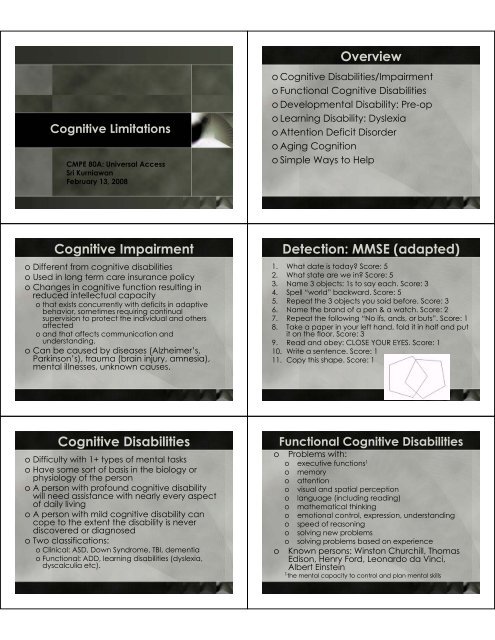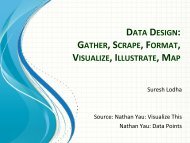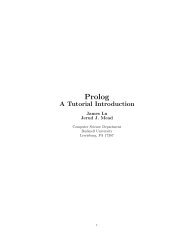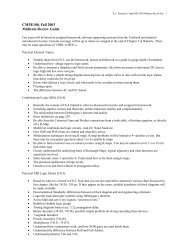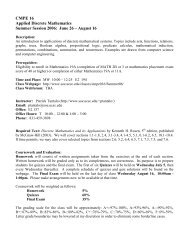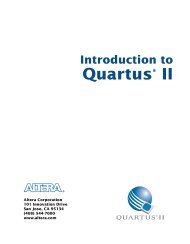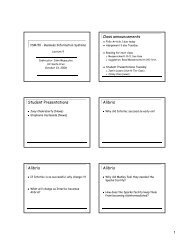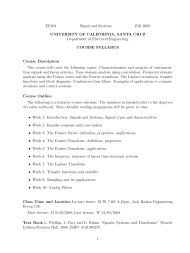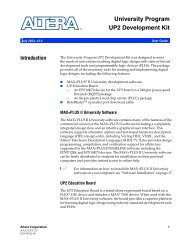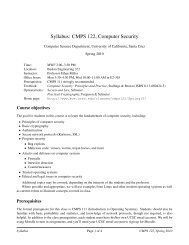Cognitive Disabilities
Cognitive Disabilities
Cognitive Disabilities
Create successful ePaper yourself
Turn your PDF publications into a flip-book with our unique Google optimized e-Paper software.
<strong>Cognitive</strong> Limitations<br />
CMPE 80A: Universal Access<br />
Sri Kurniawan<br />
February 13, 2008<br />
<strong>Cognitive</strong> Impairment<br />
o Different from cognitive disabilities<br />
o Used in long term care insurance policy<br />
o Changes in cognitive function resulting in<br />
reduced intellectual capacity<br />
o that exists concurrently with deficits in adaptive<br />
behavior, sometimes requiring continual<br />
supervision to protect the individual and others<br />
affected<br />
o and that affects communication and<br />
understanding.<br />
o Can be caused by diseases (Alzheimer’s,<br />
Parkinson’s), trauma (brain injury, amnesia),<br />
mental illnesses, unknown causes.<br />
<strong>Cognitive</strong> <strong>Disabilities</strong><br />
o Difficulty with 1+ types of mental tasks<br />
o Have some sort of basis in the biology or<br />
physiology of the person<br />
o A person with profound cognitive disability<br />
will need assistance with nearly every aspect<br />
of daily living<br />
o A person with mild cognitive disability can<br />
cope to the extent the disability is never<br />
discovered or diagnosed<br />
o Two classifications:<br />
o Clinical: ASD, Down Syndrome, TBI, dementia<br />
o Functional: ADD, learning disabilities (dyslexia,<br />
dyscalculia etc).<br />
Overview<br />
o <strong>Cognitive</strong> <strong>Disabilities</strong>/Impairment<br />
o Functional <strong>Cognitive</strong> <strong>Disabilities</strong><br />
o Developmental Disability: Pre-op<br />
o Learning Disability: Dyslexia<br />
o Attention Deficit Disorder<br />
o Aging Cognition<br />
o Simple Ways to Help<br />
Detection: MMSE (adapted)<br />
1. What date is today? Score: 5<br />
2. What state are we in? Score: 5<br />
3. Name 3 objects: 1s to say each. Score: 3<br />
4. Spell “world” backward. Score: 5<br />
5. Repeat the 3 objects you said before. Score: 3<br />
6. Name the brand of a pen & a watch. Score: 2<br />
7. Repeat the following “No ifs, ands, or buts”. Score: 1<br />
8. Take a paper in your left hand, fold it in half and put<br />
it on the floor. Score: 3<br />
9. Read and obey: CLOSE YOUR EYES. Score: 1<br />
10. Write a sentence. Score: 1<br />
11. Copy this shape. Score: 1<br />
Functional <strong>Cognitive</strong> <strong>Disabilities</strong><br />
o Problems with:<br />
o executive functions 1<br />
o memory<br />
o attention<br />
o visual and spatial perception<br />
o language (including reading)<br />
o mathematical thinking<br />
o emotional control, expression, understanding<br />
o speed of reasoning<br />
o solving new problems<br />
o solving problems based on experience<br />
o Known persons: Winston Churchill, Thomas<br />
Edison, Henry Ford, Leonardo da Vinci,<br />
Albert Einstein<br />
1 the mental capacity to control and plan mental skills
Problems with Daily Life<br />
o executive functions:<br />
o carrying out a sequence of operations<br />
o managing a stack of goals and sub-goals<br />
o memory:<br />
o memorizing a sequence of actions<br />
o learning a new task<br />
o attention and perception:<br />
o interpreting a complex display<br />
o language:<br />
o understanding error messages/cues<br />
o spelling a search term<br />
o speed of reasoning:<br />
o responding to a timed menu<br />
o When interacting with technology<br />
oAttracted by bright colors, loud noises, animation<br />
oSome tended to click anywhere / anything<br />
oAvatars were positively responded to<br />
oDragging was a problem for some<br />
oConstantly need assurance and feedback<br />
oActivities with no right or wrong are preferred – but<br />
rewards are good<br />
oThey remember the thing they like<br />
o Not many applications are out there<br />
oMany are too cognitively complex<br />
oCost – esoteric feature, specialized market<br />
oBut they have similar needs to others<br />
Learning disability: dyslexia<br />
o Symptoms (cont’d):<br />
o Sequencing: difficulty remembering series of<br />
numbers, events, nursery rhymes<br />
o Motor: fine motor skill (tying shoe laces), 20% are<br />
late walkers, problems skipping, catching<br />
o Laterality: 25% show preference for using their left<br />
hand, 70% are late in deciding which hand to use.<br />
o See all of these:<br />
Developmental <strong>Disabilities</strong><br />
o Developmental stages:<br />
o Sensori-motor (birth—2 years)<br />
o Pre-operational (ages 2-7)<br />
o Concrete Operational (ages 7-11)<br />
o Formal Operational (ages 11 and up)<br />
o Early pre-op stage<br />
o Slower information processing skills<br />
o Need approval and reassurance<br />
o Little patience<br />
o Learn through play<br />
o Limited fine motor skills<br />
o Limited attention span<br />
o Limited vocabulary<br />
Learning disability: dyslexia<br />
o Literally: problem with language<br />
o Most common learning disability (85%)<br />
o In 1876 doctors though it was vision problem<br />
o 85% come from family with dyslexia<br />
o 60% are late talkers and have word-naming<br />
problems.<br />
o 30% can describe a person or object, but are<br />
unable to put a name to them<br />
oSymptoms:<br />
o Spelling: reversal of letters and figures (b/d, 15/51)<br />
o Writing: difficulties in expression, sentence<br />
structure, punctuation<br />
o Auditory: problem remembering how a word<br />
sounds<br />
Dyslexia in Chinese<br />
o confusion with similar-looking characters;<br />
o difficulty in understanding that the same characters<br />
can have different meaning and pronunciation<br />
o difficulty in understanding that the meaning of a<br />
character may depend on its context<br />
o inability to comprehend that different characters may<br />
have the same pronunciation but<br />
different tones or the same<br />
pronunciation and tone but different<br />
meanings<br />
o problems with the proper sequences<br />
of strokes in writing characters
Dyslexia in Arabic<br />
o Arabic: Alphabetic - 28 letters<br />
o Consonants - letters<br />
o Vowels - diacritics<br />
oCursive script<br />
o Bi-Directional<br />
o Letters: RTL<br />
oNumbers: LTR<br />
oOrthography<br />
Visual<br />
complexity<br />
o Shallow – diacritics/vowelized<br />
oDeep –no vowels hrd can be<br />
heard, hard, hired, herd<br />
o Full justification works better<br />
o Also have font types<br />
sensory inputs:<br />
eyes<br />
ears<br />
sensory<br />
buffers<br />
Visual Image<br />
Store<br />
Perceptual<br />
Processor<br />
Long-term Memory<br />
Working Memory<br />
Auditory Image<br />
Store<br />
Motor<br />
Processor<br />
<strong>Cognitive</strong><br />
Processor<br />
fingers, limbs, vocal system<br />
Phological<br />
processing<br />
Attention Deficit Disorder<br />
o Often fidgets and squirms<br />
o Difficulty remaining seated<br />
o Easily distracted<br />
o Difficulty waiting to take<br />
turns<br />
o Often blurts out answers<br />
before question<br />
completed<br />
o Difficulties following<br />
instruction<br />
o Difficulties sustaining task<br />
attention<br />
o Often shifts from one<br />
activity to another<br />
o Difficulty working<br />
quietly<br />
o Often talks<br />
excessively<br />
o Interrupts or intrudes<br />
on others<br />
o Seems not to listen<br />
o Loses necessary<br />
things (books, toys)<br />
o Behaves in<br />
dangerous ways<br />
without thought<br />
Human Information Processing Aging Cognition<br />
Simple ways to help<br />
o Use consistent layouts and formats<br />
o Use left-justification for alphabet-based<br />
languages<br />
o Present information in more than 1 formats<br />
o Use clear and simple wording and easy to<br />
understand graphical cues<br />
o Use judicious white space<br />
o Always provide step-by-step instructions<br />
o In user interfaces/websites:<br />
o Allow the user to control: font sizes, font styles,<br />
background/text colors.<br />
o Make sure the page/interface is readable<br />
by a screen reader<br />
o Allow the user to turn off any animated elements,<br />
pop-up windows, and any distracters in general<br />
Tode or mot to pe<br />
o Episodic memory is impaired while semantic<br />
memory remains relatively intact<br />
o Language comprehension improves<br />
o More affected by interference in LTM tipof-the-tongue<br />
phenomenon<br />
o Working memory deficit (forgetting)<br />
o Slower cognitive processing<br />
o More easily distracted by irrelevant material<br />
(reduced selective attention).<br />
o Less ability to have divided attention<br />
o Knock-off effect (impairment at sensory level<br />
causes more load in already reduced<br />
cognition)<br />
Helping through Universal Design<br />
o Good metaphor: use real-world objects to<br />
represent functions<br />
o Good mapping: doesn’t need a rocket scientist<br />
to figure out which controls which<br />
o Safety from prosecution: Make it difficult for users<br />
to do unintended errors, undo and redo,<br />
automatic backup.
Helping through Universal Design<br />
o Good visibility: Make things visually clear<br />
without having to guess<br />
o Place constraint: Hide irrelevant things<br />
o Good affordance: make it so that it’s clear<br />
what can be done with objects


